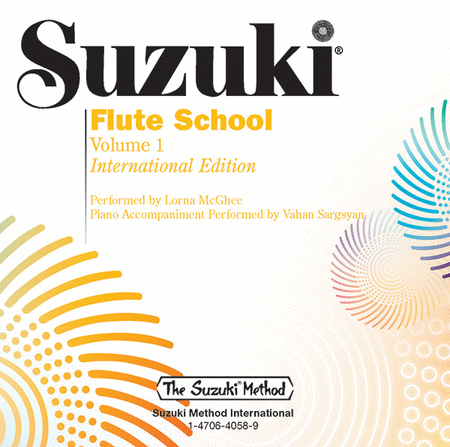Suzuki Flute School, Volume 1
International Edition
-
Ships in 1 to 2 weeks
Details
Description
SKU: AP.42240
Volume 1. International Edition. By Lorna McGhee. By Dr. Shinichi Suzuki. This edition: International. Method/Instruction; Suzuki; Woodwind - Flute (Suzuki). Suzuki Flute School. CD. Alfred Music #00-42240. Published by Alfred Music (AP.42240).ISBN 9781470640583. UPC: 038081528786. English. Piano acc. Vahan Sargsyan.
Teach flute with the popular Suzuki Flute School! The Suzuki Method of Talent Education is based on Shinichi Suzuki's view that every child is born with ability, and that people are the product of their environment. According to Shinichi Suzuki, a world-renowned violinist and teacher, the greatest joy an adult can know comes from developing a child's potential so he/she can express all that is harmonious and best in human beings. Students are taught using the mother-tongue approach. Each series of books for a particular instrument in the Suzuki Method is considered a Suzuki music school, such as the Suzuki Flute School. Suzuki lessons are generally given in a private studio setting with additional group lessons. The student listens to the recordings and work with their Suzuki flute teacher to develop their potential as a musician and as a person. This accompaniment CD is essential for Suzuki flute lessons.
Titles: Mary Had a Little Lamb (Folk Song) * Fireflies (Children's Song) * Kagome Kagome (Children's Song) * Cuckoo (Folk Song) * Lightly Row (Folk Song) * Twinkle, Twinkle, Little Star Variations (Suzuki-Takahashi) * Go Tell Aunt Rhody (Folk Song) * Amaryllis (Ghys) * Allegro (Suzuki) * The Honeybee (Folk Song) * Long, Long Ago (Bayly) * Lullaby, Op. 98, No. 2 (Schubert) * Moon over the Ruined Castle (Taki) * Minuet, Minuet III from Suite in G Minor for Klavier, BWV 822 (Bach) * Minuet, BWV Anh. II 114/Anh. III 183 (Bach) * Minuet, BWV Anh. II 116 (Bach) * Bourrée from Sonata No. 3 in G Major for Flute and Basso Continuo, Op. 1, No. 5, HHA IV/3 No. 5 (Handel) * Fingering Chart.
The International editions include an updated title page that designates the book as the International Edition.
About Suzuki Method
The Suzuki Method is based on the principle that all children possess ability and that this ability can be developed and enhanced through a nurturing environment. All children learn to speak their own language with relative ease and if the same natural learning process is applied in teaching other skills, these can be acquired as successfully. Suzuki referred to the process as the Mother Tongue Method and to the whole system of pedagogy as Talent Education. The important elements of the Suzuki approach to instrumental teaching include the following:an early start (aged 3-4 is normal in most countries); the importance of listening to music; learning to play before learning to read; -the involvement of the parent; a nurturing and positive learning environment; a high standard of teaching by trained teachers; the importance of producing a good sound in a balanced and natural way; core repertoire, used by Suzuki students across the world; social interaction with other children. Suzuki students from all over the world can communicate through the language of music.

 Share
Share